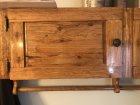I picked up a ton of Leyland Cypress (I'm fairly certain, homeowner said tree service called it Yellow Cedar. Related, but I'm doubting someone went out of their way to plant some here in Virginia) earlier this week. I noticed the end grain was checking around the pith on the logs, despite having been cut down a day or two prior. I cut some blanks yesterday, removing the pith, and started a rough bowl but am still seeing some checking near where the pith was on it. From what I've read, this should be a relatively stable wood. Does anyone have any experience with it?
-
December 2025 Turning Challenge: Single Tree! (click here for details) -
Congratulations to Bob Henrickson, People's Choice in the November 2025 Turning Challenge (click here for details) -
Congratulations to John Dillon for "Chinquapin Oak" being selected as Turning of the Week for December 22, 2025 (click here for details) -
Welcome new registering member. Your username must be your real First and Last name (for example: John Doe). "Screen names" and "handles" are not allowed and your registration will be deleted if you don't use your real name. Also, do not use all caps nor all lower case.
You are using an out of date browser. It may not display this or other websites correctly.
You should upgrade or use an alternative browser.
You should upgrade or use an alternative browser.
Leyland Cypress
- Thread starter John Roberts
- Start date
- Joined
- Jan 27, 2005
- Messages
- 13,186
- Likes
- 5,765
- Location
- Dalworthington Gardens, TX
- Website
- pbase.com
I picked up a ton of Leyland Cypress (I'm fairly certain, homeowner said tree service called it Yellow Cedar. Related, but I'm doubting someone went out of their way to plant some here in Virginia) earlier this week. I noticed the end grain was checking around the pith on the logs, despite having been cut down a day or two prior. I cut some blanks yesterday, removing the pith, and started a rough bowl but am still seeing some checking near where the pith was on it. From what I've read, this should be a relatively stable wood. Does anyone have any experience with it?
You probably should remove any wood that is closer to the pith than one inch. I've never turned it, but I would suggest to very quickly rough turn it then coat it with Anchorseal and let it dry for a few months before doing the final turning.
Thanks Bill! I cut a few more blanks this evening and tried removing more of the pith. I'll have to remember to let you all know how it turns out.You probably should remove any wood that is closer to the pith than one inch. I've never turned it, but I would suggest to very quickly rough turn it then coat it with Anchorseal and let it dry for a few months before doing the final turning.
- Joined
- Apr 1, 2015
- Messages
- 603
- Likes
- 450
- Location
- Sitka, Alaska, United States
- Website
- www.zachlaperriere.com
I can't speak for species, but I turn a lot of yellow cedar, as it's native here in Alaska. It is a true cypress, not a cedar at all—and yes it end checks like crazy. I have seen it end check in under five minutes! Today was a balmy 62 degree and fairly dry 4X4s were checking in under an hour in overcast skies.
Anchor seal is a great bet as Bill suggested. Yellow cedar is a very stable wood, being among the woods that shrinks the least of all N American woods—but it still end checks like nuts if there is much moisture. You want to make sure it is completely dry before sanding, as it will also heat check.
Anchor seal is a great bet as Bill suggested. Yellow cedar is a very stable wood, being among the woods that shrinks the least of all N American woods—but it still end checks like nuts if there is much moisture. You want to make sure it is completely dry before sanding, as it will also heat check.
I can't speak for species, but I turn a lot of yellow cedar, as it's native here in Alaska. It is a true cypress, not a cedar at all—and yes it end checks like crazy. I have seen it end check in under five minutes! Today was a balmy 62 degree and fairly dry 4X4s were checking in under an hour in overcast skies.
Anchor seal is a great bet as Bill suggested. Yellow cedar is a very stable wood, being among the woods that shrinks the least of all N American woods—but it still end checks like nuts if there is much moisture. You want to make sure it is completely dry before sanding, as it will also heat check.
Great to know Zach! I think Leyland's and yellow cedar may be close cousins, and I'm certainly seeing some of the same behavior to support that. Great advice though!

